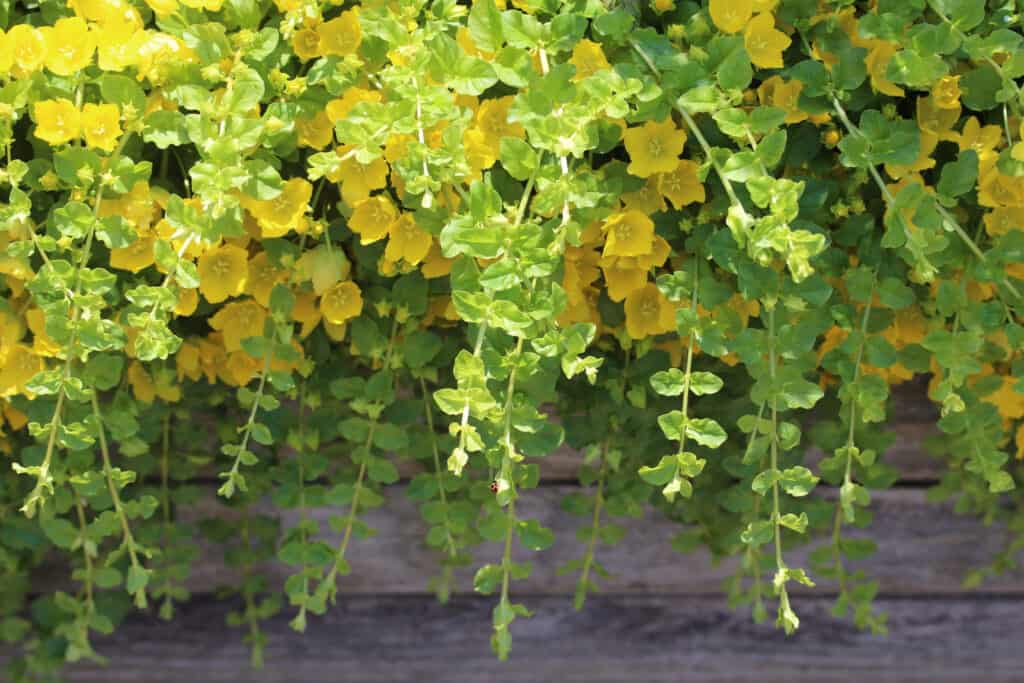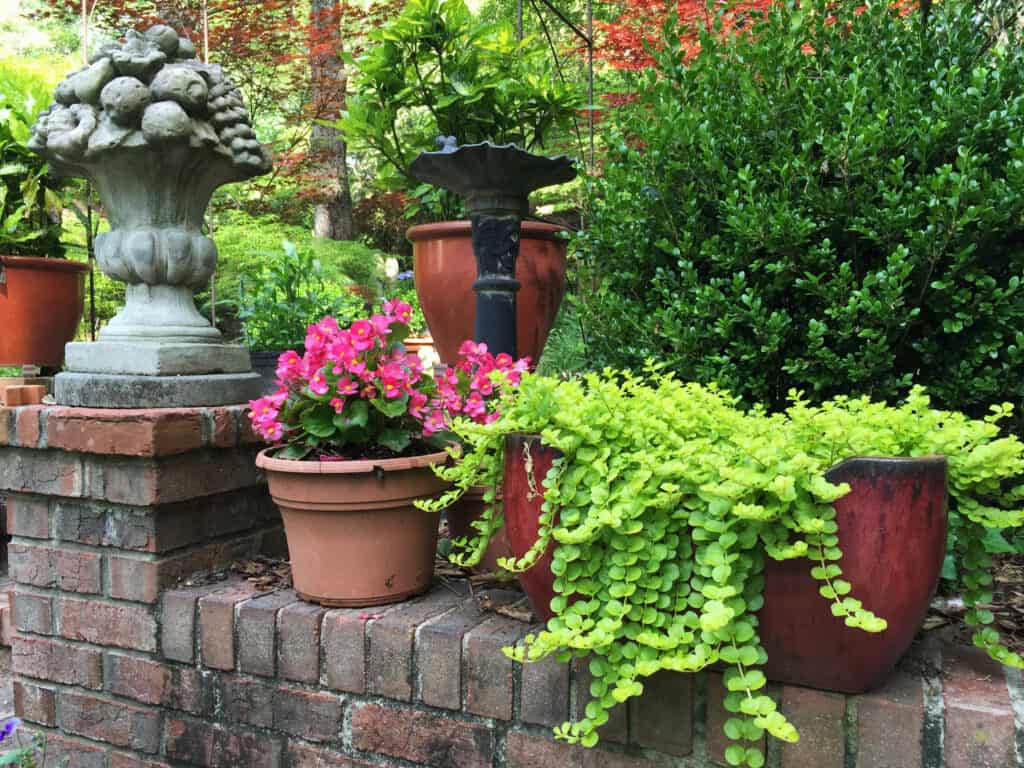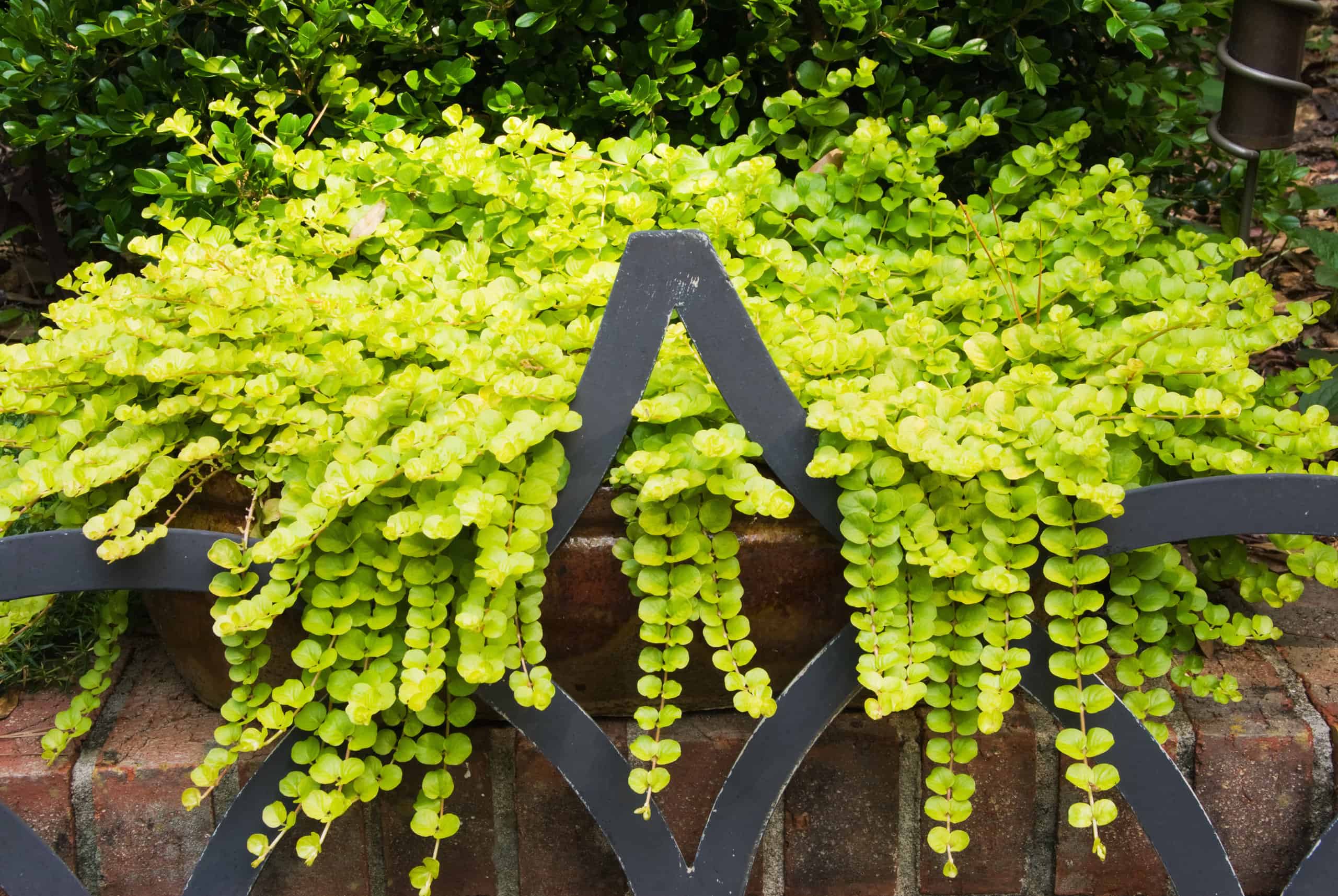Creeping Jenny. You either love it or hate it! This pretty mat-forming evergreen is a staple around the pond and container edges, but it can get out of hand without supervision. Let’s take a look at how to grow Creeping Jenny without it turning into an invasive weed. We’ll start with the simple question – is Creeping Jenny perennial or annual?
Creeping Jenny: Perennial or Annual?
Creeping Jenny is an evergreen perennial. It’s an especially hardy plant that loves damp soil and grows quickly. Because it’s a perennial and not an annual, it will get bigger and re-flower every year.
The Difference Between Annual and Perennial
Annual plants complete their lifecycle in one year. They germinate, grow stems, leaves, and flowers and set seed in one growing season. The majority of annual plants grow in spring and die off in late autumn.
Perennials, on the hand, live for two or more years. Evergreen perennials retain their leaves and then grow extra foliage and flowers each year. Deciduous perennials die back in cold areas. Sometimes they die back to barely anything but regrow when warmer weather returns.
Another type of plant is a biennial. Some people think this means they flower twice a year, but what it actually refers to is a plant that germinates and grows a few leaves in year one, then completes its cycle in year two with flowers and seeds. It will die after setting seeds. Biennial plants include parsley and dianthus such as Sweet Williams.
Because evergreen Creeping Jenny is a perennial not an annual, it grows bigger and flowers each year.
What Is Creeping Jenny?

Creeping Jenny is often confused with Creeping Charlie, but Creeping Charlie has purple flowers while Creeping Jenny has yellow flowers.
©iStock.com/AKIsPalette
Creeping Jenny (Lysimachia nummularia) sits in the Primulaceae family of primroses. Related species include Shooting Stars (Dodecatheon meadia), and Scarlet Pimpernel (Anagallis arvensis). It’s native to Europe, but early settlers naturalized it in North America to the extent it’s considered invasive in some areas.
Creeping Jenny is a popular hardy perennial and has lots of common names such as Herb Twopence, Moneywort, and Twopenny Grass. It’s easily recognized by its rounded green opposite leaves and yellow star-shaped flowers that can reach one inch in diameter.
Creeping Jenny is a low-growing, spreading perennial. Plants that spread across the ground are called prostrate, not to be mixed up with prostate, something quite different! Prostrate plants grow like doormats across the ground and they are excellent soil protectors.
Sometimes Creeping Jenny is mixed up with Creeping Charlie, but there’s an obvious difference. Creeping Charlie has purple flowers.
Popular cultivars of Creeping Jenny include Goldilocks and Sunburst, but the cultivar Aurea is most commonly sold. It’s the same as common Creeping Jenny, but has golden-yellow leaves instead of green ones.
Over the years, it’s been used as medicine to treat diarrhea, scurvy, whooping cough, open wounds, and old painful scars. Moving to more modern research Creeping Jenny shows some potential in the fight against prostate cancer.
Is Creeping Jenny A Weed?
This is an interesting question, because what is a weed?
A weed is perhaps best looked at as a plant in the wrong place or one that’s become a nuisance.
Creeping Jenny certainly has the potential to become invasive. It’s out-competing native flora around the Great Lakes and is under observation in Indiana, North Carolina, and Virginia. Chemicals and controlled fires are used to combat its spread.
If it’s well managed, then Creeping Jenny is a beautiful and useful garden plant, especially around ponds where it provides cover for small fish and amphibians.
It can get out of control in damp areas without regular pruning and may well take over the lawn! If you’re concerned about Creeping Jenny taking over, then consider growing it in a container. More about that later!
Will Creeping Jenny Kill Other Plants?
It isn’t toxic to plants, but Creeping Jenny can smother other low-growing plants. It’s so vigorous that it grows and spreads without any help, a bit like mint! Cultivars such as Aurea and Goldilocks are not so invasive. Because they don’t tend to grow so quickly, they’re a better choice for small gardens.
Why Is It Called Creeping Jenny?
Its scientific name nummularia is Latin for “coin-like,” referring to its rounded flowers and foliage (it’s also where the common name moneywort comes from). “Creeping” illustrates its creeping prostrate form, but no one seems to know where Jenny fits in!
What To Do With Creeping Jenny Over Winter
Creeping Jenny and its cultivars are hardy in United States Department of Agriculture zones 4–9. Because it’s an evergreen perennial not an annual, it grows bigger and re-flowers in spring, but in zones 8-9 it will continue to grow during the winter months.
To help it through the winter in cold zones you can take the following steps:
- Don’t water it once frost has set in
- Trim back brown or excess foliage in late autumn for good air circulation.
- Move containers to a wall side or put them in a greenhouse. Container-grown plants are at more risk of frost because their roots are not protected by a thick layer of soil.
Creeping Jenny is a good way to help winterize other plants. Because it covers soil and soaks up excess rain, it can prevent shrub root rot. It’s cover also protects roots from frost and snow.
Is Creeping Jenny Toxic To Cats Or Dogs?
No toxic effects have been reported for cats, dogs, horses or other animals, but it’s never a good idea to let a pet eat large quantities of wild plants.
Creeping Jenny’s genus of flower is favored by the ground-nesting macropis species of bee. These bees are attracted to its floral oils and use them to build hive cells and feed larvae!
Creeping Jenny In A Hanging Basket

Creeping Jenny is often kept in pots because it spreads very easily.
©iStock.com/LCBallard
Creeping Jenny is a hardy perennial that prefers damp soil, but it’s so tough it will also grow in a well-watered container.
Because it has long stems, it makes a very attractive hanging basket and covers up the bare edges of container shrubs. Some people remove patio slabs to grow a patch of evergreen Creeping Jenny and others grow it over a wall to cover up brickwork.
Growing Creeping Jenny in a pot is a great way to prevent its spread, but it will need plenty of water.
Creeping Jenny Is An Evergreen Perennial
Now we know that Creeping Jenny is a perennial not an annual, it’s easy to see why it’s so popular.
This plant has attractive rounded foliage, golden flowers, and it’s a cinch to grow. Just keep an eye on how far it’s spreading and you can have hardy, year-round greenery that protects the soil and looks fabulous in a hanging basket.
Up Next:
Thank you for reading! Have some feedback for us? Contact the AZ Animals editorial team.








